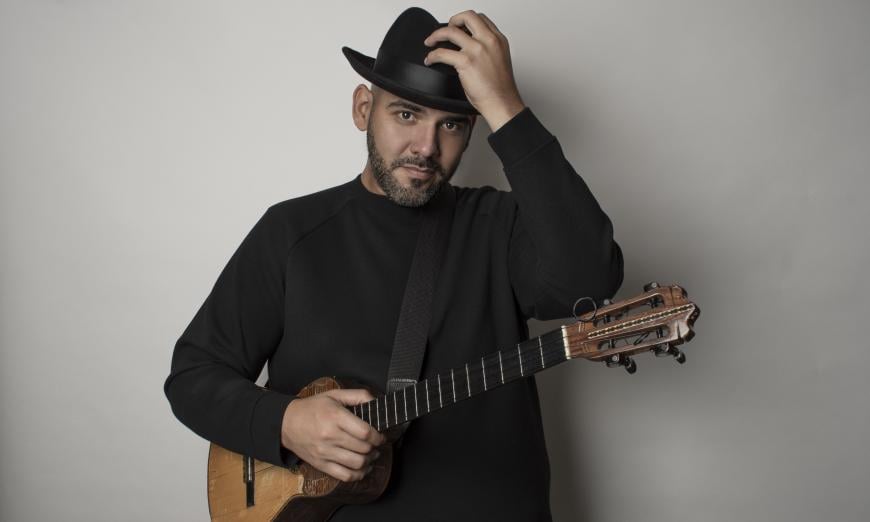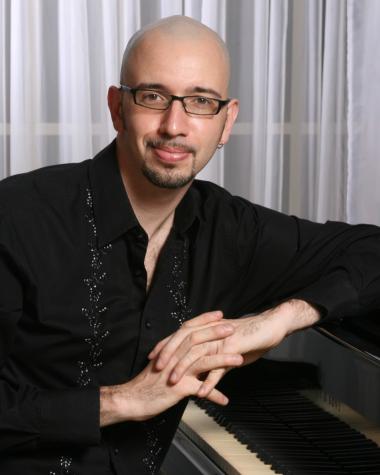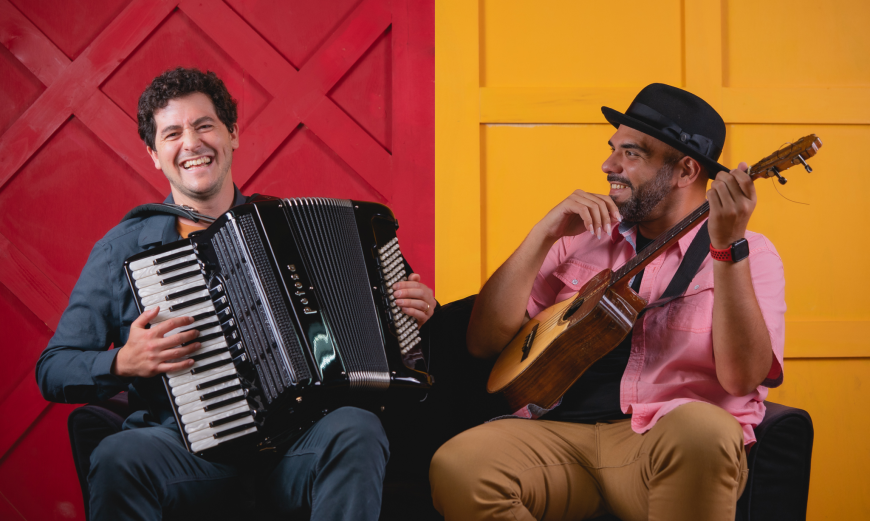
The four-string ukulele-like cuatro is the national instrument of Venezuela, and in the hands of Latin Grammy-winner Jorge Glem, it’s opened doors to the world’s most august concert halls, jazz clubs, and theaters. Last year, he performed at Carnegie Hall for the premiere of Jon Batiste’s omni-stylistic American Symphony. And on Nov. 24–26, he’ll be at Davies Symphony Hall under the baton of longtime friend Gustavo Dudamel. Glem will be making his San Francisco Symphony debut in Gonzalo Grau’s Odisea: Concerto for Venezuelan Cuatro and Orchestra.
It’s the third performance of the piece, which Glem premiered last year at the Hollywood Bowl with the Los Angeles Philharmonic (under Dudamel). In many ways the concerto is a musical travelogue that connects Glem’s northeastern hometown, Cumaná, with the city of Barquisimeto in Venezuela’s central northwest, where Dudamel grew up. Before Grau had written a note, he and Glem were musically mapping the journey.

“I sent him many examples of the traditional music of my city in eastern Venezuela, where there is ‘mainland music’ and ‘navigation music,’” Glem, 41, said on a recent video call from the Dominican Republic, speaking in Spanish. “Navigation music is what fishermen made when they went out to sea and didn’t know if they’d be returning home. This music is nostalgic: malagueña, galerón, jotas, and polos.”
When the fishermen returned home, they were greeted with festive sounds, like joropos con estribillos. Glem explained the rhythmic and emotional trajectory to Grau, who was born and raised in Caracas, and sent him examples of each style “because he wanted to do a trip from the northeast, where I’m from, down the highway, all the way to Barquisimeto, the city where Gustavo is from,” Glem said. “It’s as if you were traveling by bus, and the music changes depending on where you are.”
The program at Davies opens with Gabriela Ortiz’s Kauyumari, which received its premiere from the LA Phil and Dudamel in 2021. The Mexico City-born composer based Kauyumari on a traditional melody of the indigenous Huichol people of northwest Mexico, a tune that Ortiz also deployed in her 1997 Kronos Quartet-commissioned Altar de Muertos (the second of her seven-part Altares series). Rounding out the program is Johannes Brahms’s famously sunny Symphony No. 2.
If the cuatro is familiar to Bay Area audiences, it’s most likely due to the work of Caracas-raised, Oakland-based percussionist and cuatro master Jackeline Rago, a creative force who’s developed a fascinating body of Venezuelan jazz. While a recent surge of Venezuelan musicians coming to the U.S. has raised the visibility of the South American nation’s musical riches, Rago was here decades ago, and her group VNote honed a sumptuously syncopated repertoire blending modern jazz with folkloric Venezuelan forms such as joropo and merengue (not to be confused with the popular Dominican dance style).

She and Glem actually performed together at the Red Poppy Art House back in 2018, and more recently she was also featured at Carnegie Hall in Batiste’s American Symphony. That Red Poppy concert was one of several that Glem played at the essential Mission District venue with San Francisco accordionist Sam Reider, one of his closest American collaborators. They’ve worked together widely since they met in 2016, just weeks after Glem arrived in New York City. With Venezuela’s political situation and economy deteriorating, he lit out for a place big enough to contain his far-flung musical passions.
“In Venezuela I had an interesting career,” said Glem, who now divides his time between the Bronx and Miami, Florida. “I always had lots of work, and I played many genres — rock, jazz, rap, funk. I asked myself, ‘Where else could I find all these types of music?’ New York was that place where I could have the opportunity to play with musicians from around the world.”
He quickly got his wish at a house party on the Upper West Side thrown by Caracas-born songwriter and producer Linda Briceño. She invited Reider to the shindig, excited to introduce him to Glem, figuring they’d get along well.
“I walked into this tiny apartment with all these Venezuelan people, bottles of rum, maracas, and a guy in the corner playing a little instrument with four strings I’d never seen before,” Reider recalled. “At the time he didn’t speak any English at all, and I barely spoke Spanish, but we had a musical connection.”
Reider and Glem started getting together regularly to jam and share tunes on accordion and cuatro. When Reider moved back to the Bay Area to earn a master’s in composition at San Francisco State University, they kept the duo together, eventually recording the Latin Grammy-nominated album Brooklyn Cumaná.
“He taught me about Venezuelan music, which is a huge universe unto itself, unlike any other Latin American folkloric music,” Reider said. “It’s all 6/6 or 3/8 or 5/8. Outside of the Balkans, I can’t think of another tradition with so many odd time signatures.”
Glem has continued to spread his wings stylistically, working with masters from across the Americas, including Cuban reed legend Paquito D’Rivera, Panamanian salsa star Rubén Blades, Colombian icon Carlos Vives, Mexican singer-songwriter Natalia Lafourcade, Puerto Rican hip-hoppers Calle 13, Guatemalan singer-songwriter Gaby Moreno, Argentine jazz vocalist Sofia Rei, and Nicaraguan salsero Luis Enrique (with whom Glem won a 2019 Latin Grammy for his work on Tiempo al Tiempo).
He’s also been working with Trinidadian trumpeter and percussionist Etienne Charles, a former member of the SFJAZZ Collective who’s featuring Glem on his Dec. 9 Miner Auditorium “Creole Christmas” concert. “The cuatro is played in Trinidad, too,” Glem said. “I only learned that recently.”
Grau’s concerto for Glem isn’t the first piece to feature the cuatro in an orchestral setting, “but this one is magical because it showcases different areas in the country,” Glem said. “And the orchestration is very good. In Venezuela there’s a rhythm called merengue, in 5/8. Many people say it’s one of the most complicated rhythms in Latin America. But Gonzalo was able to write it out in such a way that the orchestra can read it easily. It’s very interesting how an orchestra can sound really good playing difficult rhythms.”



